Kraków 2007-09-01
269 Section 1984-05-05
OKB Suchoj Su-22 M 4 K, Su-22 UM 3 K
Poland
History
Supersonic fighter-bomber plane, with a variable-geometry wing.
See Sukhoi Su-20 1974
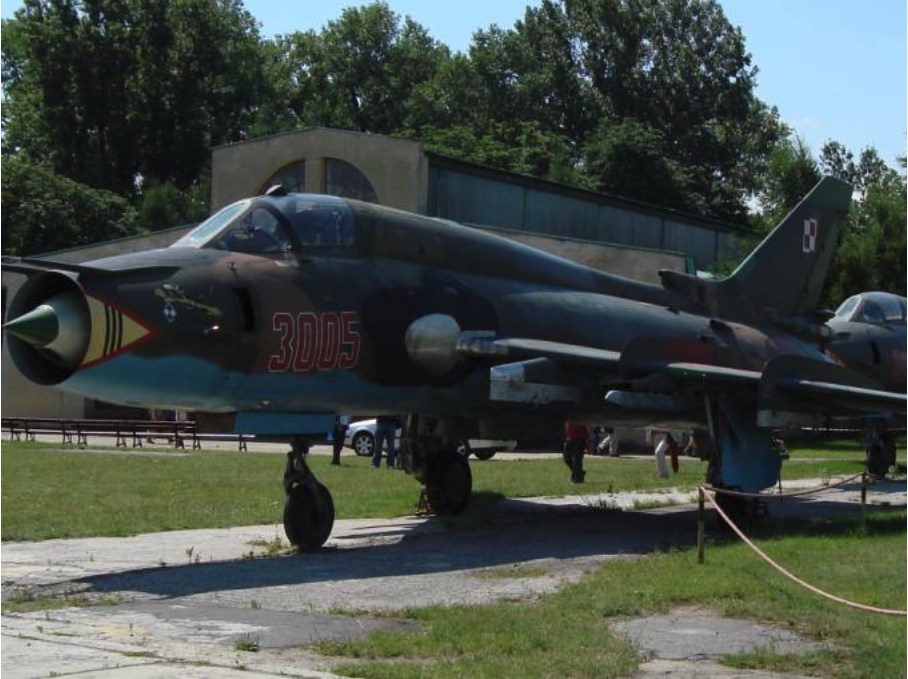
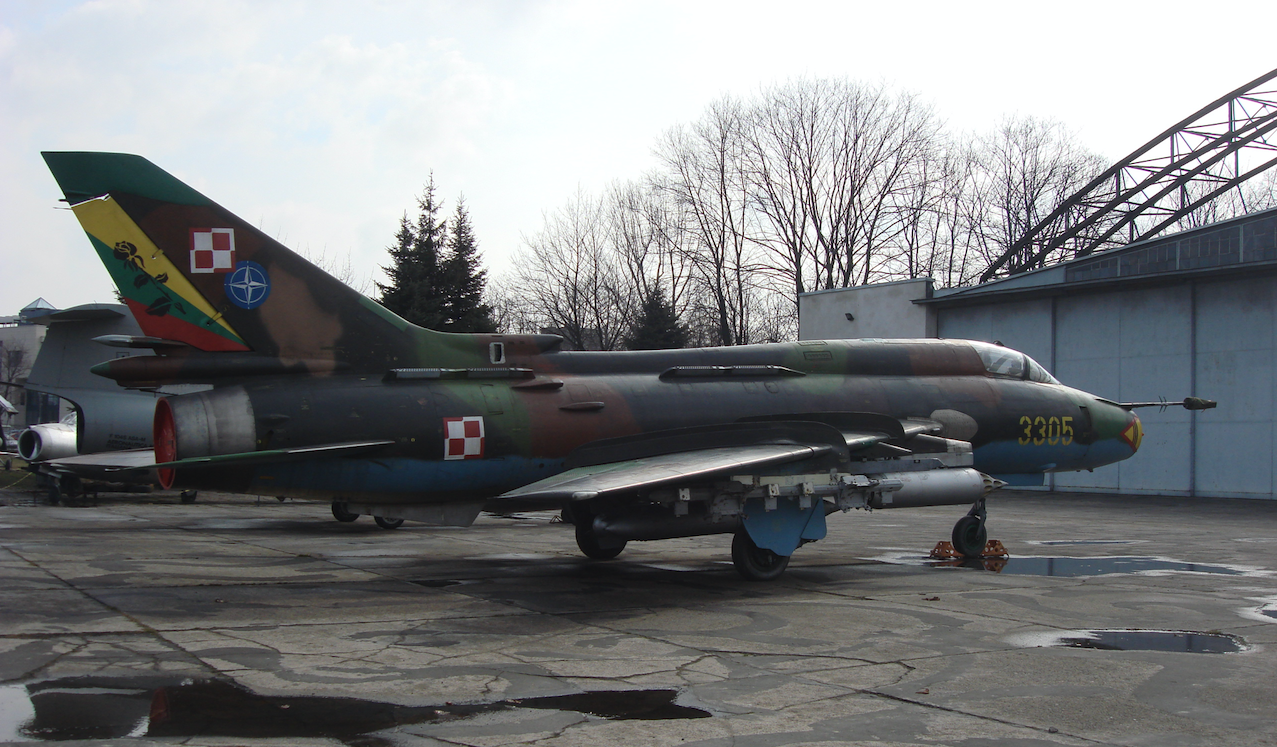
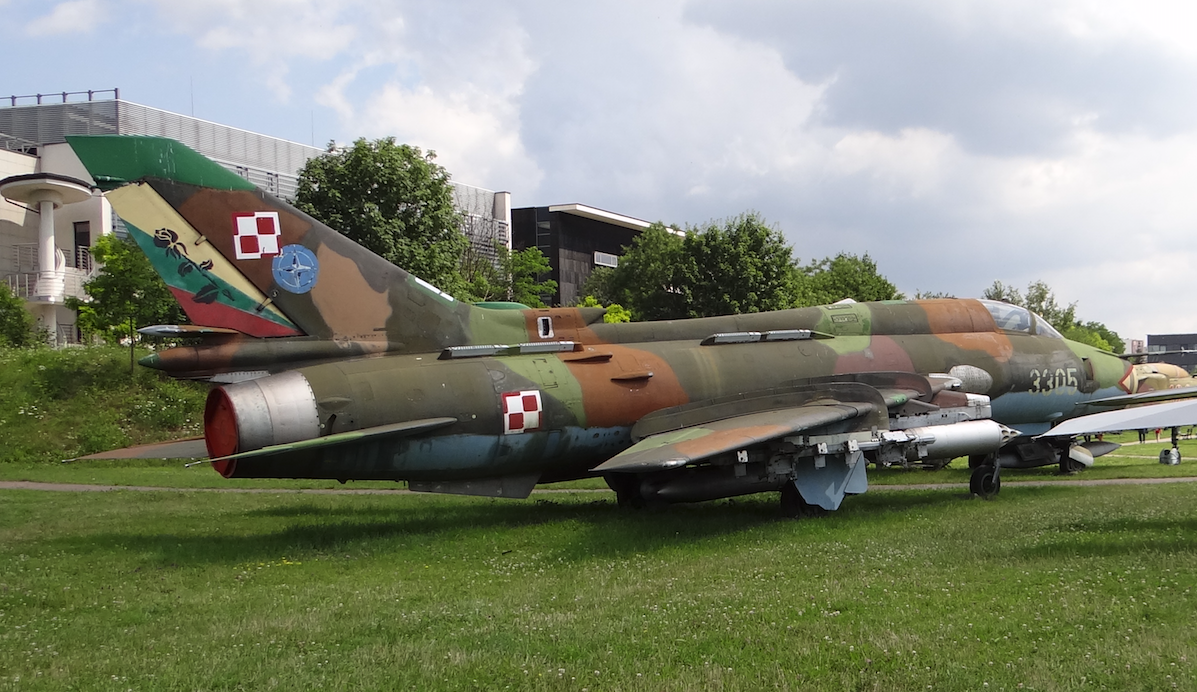
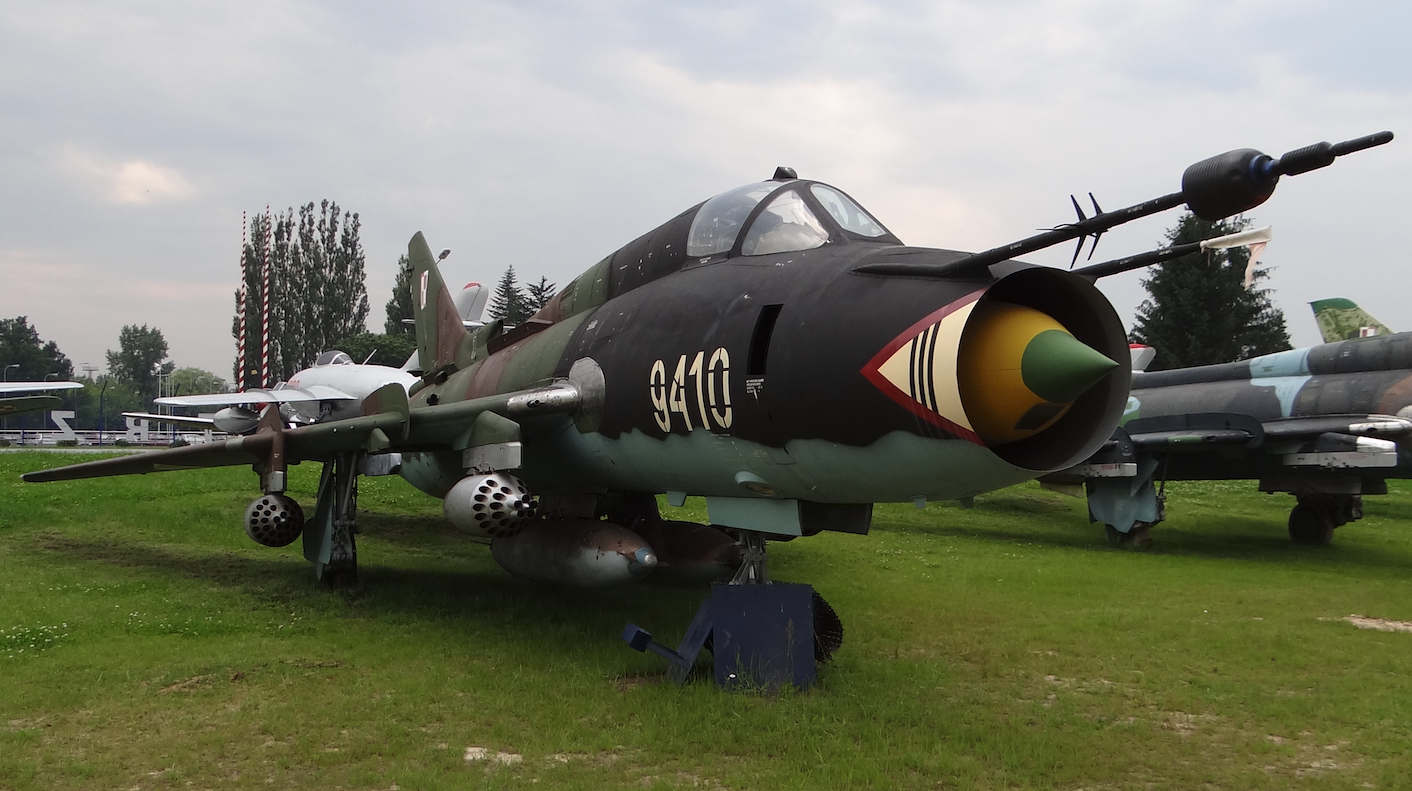
History
In CCCP, the Su-17 plane, despite constant modifications and the creation of its second generation, still did not meet the assumptions made. It was not about volatile properties and performance, but about the possibility of effectively attacking ground targets in "all weather conditions". The variable geometry of the wings was not a sufficient argument here. The key to success was new equipment based on modern electronics, and the one at CCCP was not there. Building highly specialized aircraft did not help solve the problem.
New assumptions
On the Su-17 M 2 fighter-bomber plane, a lot of emphasis was put on the installation of the target electronics and weaponry. The pilot's working conditions have been improved by expanding the cabin. However, the front of the hull limited visibility. In addition, there was no training and combat aircraft on which it would be safe to train new pilots. Su-7 U did not fulfill its role well anymore. Therefore, in October 1974, the Soviet authorities (CPC Central Committee and RM CCCP) ordered OKB Suchoj to build two new Su-17 varieties;
-
S-52 - with improved visibility and aiming conditions and electronics unified with the MiG-27 M.
-
S-52 U - training and combat with the priority of construction and production.
Su-17 version S-52. 1976
The front part of the fuselage was rebuilt. The idea was to have new equipment and to improve the working conditions of the pilot. The front element of the fuselage was shortened, the air grip was lowered and the rest was thickened. The hull axis was inclined downwards by 3 degrees, starting from 13 frames forward. Now the visibility from the cabin has become comparable to the view from planes that do not have the best air holds. The superstructure was enlarged behind the cabin. To improve the directional stability, the vertical tail was increased, adding an additional element and a so-called inflow was added. Later, a small aerodynamic steering wheel was added under the fuselage.
The cabin itself has been enlarged. The pilot's seat was raised, which improved the pilot's working conditions. In this way, the angle of observation forward has been increased, down from 9 degrees to 15 degrees. The pilot's safety has increased through the use of a K-36 D Series 2 ejectable chair, class 0-75, and a little later 0-0 grade.
The number of weapon assembly points has been increased to 10, although there are "national" versions with 8 points. This additional pair of points for weapons is under the wings and is used exclusively to carry defensive weapons composed of R-60, R-55 or R-13 missiles.
The DISS-7 automatic navigation system, to bypass obstacles, is now placed inside the fuselage, not as previously in the fairing under the fuselage.
These changes resulted in the creation of an easily recognizable "humped" silhouette of the aircraft.
The aircraft was given a reinforced chassis and new wheels to maintain the possibility of taking off from ground-level airports. Enlarged aircraft fuselage allowed to increase the fuel supply by 100 kg. The aircraft's armor has been improved, the weight of which has increased from 165 kg to 195 kg. The lifting capacity has been increased to 4 250 kg. The take-off weight of the aircraft increased by 400 kg.
The aircraft's equipment has been changed. The modified SAU-22 M 1 system allowed for the first time an automatic flight with supersonic velocity at a height of 200 m. Built; RW-15 radio altimeter, SRO-1 P and SO-69 devices.
The first S-52 prototype was an aerodynamic demonstrator, as the actual electronics were not yet available. The first flight of the S-52 aircraft took place in the first half of 1976. Probably 1976-04-04. He joined the second prototype for state tests in January 1977. It already had the Klen-PS laser station built in the front of the hull, which took over the functions performed so far by the Fon-1400 laser rangefinder and the target station of the Prozktor-1 target. The Klen-PS station enabled the measurement of a distance of up to 10,000 m, and a backlight of 7,000 m. What is important, the laser beam could be deflected horizontally + -12 degrees, and vertical +6 degrees, -30 degrees, which allowed some freedom in maneuvering and even horizontal flight attack.
ASP-17 and PBK-3-17 S sights were integrated in one equipment complex. Now it was named ASP-17 B. The first phase of the state trials was completed in the second half of 1977, however, many comments and conclusions were made for quick implementation. The systems were highly emergency and did not work well together. There were problems with the current assessment of the aircraft's motion parameters in relation to the attack object. The system (processor) did not keep up with the viewfinder calculations.
Production Su-17 M 3 (Su-19)
At that time, a third prototype and another two were built. All five prototypes took part in the second phase of state tests in March-December 1978. According to anecdotal evidence in the autumn of 1977, the second prototype S-52-2 was lost. In December 1978, the plane was conditionally recommended for production because the tests were not entirely satisfactory. The plane was to receive the designation Su-19. This happened during a large high-level scandal, as several dozens of manufactured and not received by the army Su-17 M 3 were in the factory in Komsomol on Amure. Finally, the Ministry of aviation forced the army to take over the aircraft conditionally, and the new designation Su-19 was not it was accepted and newly produced aircraft received the designation Su-17 M 3. It is not excluded that the military demanded a much more modern construction.
It turned out that the Su-17 M 3 was the most-produced version of this aircraft. 488 copies were built in the period from 1976 to 1981. Due to the long production period and emerging problems, serial production distinguishes three stages;
-
In the first model, the S-52 distinguished new shapes and technological changes. However, avionics came from Su-17 M 2.
-
In the second stage, the S-52 M is distinguished by the larger end of the vertical stabilizer and the sub-fuselage of the aerodynamic steering. This was the result of the disclosed lack of directional stability at large angles of attack and with the wing set to the max. Slant. Gradually, in the period 1979-1980, in the repair plants previous aircraft were brought to the S-52 M.
-
Only the third production stage, 1978-1979. planes were standard S-52 M 3 with target avionics and weapons. It was the 38th production series.
Su-17 M 3 aircrafts received a Radio-Electronic Combat system consisting of the SPS-141 MWG Gwozdika active stations in the container. This station not only indicated the direction of radiation, but using the data library gave the type of hostile station and the type of danger. It was supplemented by a thermal dipolar ejector KDS-23, placed on the fuselage.
In 1981, Su-17 M 3 P machines were assembled from the 54 production series. They are adapted to carry new Ch-27 and Ch-58 missiles. The search for and displaying the target is carried out by the Wjuga-17 apparatus located in the reservoir under the fuselage in front of the aerodynamic steering wheel. The plane was also re-equipped with laser-guided Ch-29 L projectiles. Can be fired like the Ch-58 missiles from the symmetrical dual AKU-58 launcher placed under the fuselage. Introduced also APU-68 UM 3 rail launchers for such missiles as; S-24, Ch-23, Ch-25 (modular). In the fire control system, a BSPPU block appeared allowing for shooting from the SPPU-22-01 gondola in the "automatic target tracking" mode, with the angle of lowering the barrel -30 degrees forward or backward.
In July 1981, Su-17 M 3 aircraft were officially adopted as armaments.
Su-17 UM 3 (S-52 U). 1975
Based on the S-52 aircraft, a training-combat variant S-52 U (S-53) was built. Aviators' seats were placed in tandem. A centralized catapulting system with K-36 D S 2 armchairs was introduced. The instructor's cabin was equipped with a periscope system. The place for the second cabin was obtained at the expense of reducing the fuel tank No. 1. In general, the fuel supply decreased to 3 050 kg.
The equipment was modified by introducing the SAU-22 MU control system. SPU-9 on-board conversation and MS-61 tape recorder added. The left cannon was dismantled, but the total weight of the aircraft increased to 10,900 kg. The lifting capacity of the weaponry decreased to 3,000 kg and therefore the second pair of sub-fuselage gates were dropped.
In September 1975, the first prototype S-52 U was flown by pilot W. A. Kreczetow. Soon the second prototype joined the first prototype. State tests were carried out in 1976, and the S-52 U aircraft was recommended for series production under the designation Su-17 U. The tests were completed in May 1977. From 1978, Su-17 UM (S-52 UW) was built with elevated vertical stabilizer and aerodynamic steering wheel under the fuselage. In the period 1979-1980 all planes were brought to the latest standard.
In July 1978, a decision was made to build a training and combat aircraft with avionics unified with Su-17 M 3. In October 1978, the prototype S-52 UM 3 was tested, but his research lasted two years and the plane went to state trials in May 1981. Its serial production already lasted from 1978 to 1979 and closed with 165 machines. Importantly, all 75 previously produced Su-17 UM aircraft were brought in 1981-1983, to the Su-17 UM 3 standard. In summary, 240 Su-17 UM 3 machines were created in total.
Su-22 M and Su-22 M 3. 1977
In February 1977, a prototype S-52 K, an export variant of Su-22 M., was tested. This plane and the first serial was used to carry out state tests from June 1978 to February 1979.
In 1977, airplanes under the designation Su-22 M, with the R-29 BS engines were purchased by Peru, followed by Libya, Angola and others. In the years 1979-1984, 272 Su-22 M machines were produced; Afghanistan, Algeria, Iraq, Yemen, Libya, Peru, Syria and Vietnam.
The Su-22 M was a variant of the early-series Su-17 M 3 with a Fon-1400 laser rangefinder. The BS-300 R-29 engine was used for the drive. So it was a combination of the front of the early Su-17 M3 fuselage with the back of the Su-22. In production, the aircraft received a higher tail and (though not always) sub-hulled aerodynamic steering wheel. The CCCP allies received missiles Ch-23 and Ch-28 for planes.
In the years 1981-1983, the Su-22 M 3 aircraft were produced with equipment for the late-series Su-17 M 3 and R-29 BS-300 engines. 59 machines were built which went to Afghanistan, Iraq and Hungary. Su-22 M-3 were delivered to Hungary in the total of 10 items and training-combat Su-22 UM-3 in the number of 3 pieces and are stationed in the base of Kecskemet (1990).
The users of both versions were offered KKR-1 recognition bunkers. They were definitely bought by Hungary (Su-22 M 3 R) and Vietnam (Su-22 MR).
Su-22 U, Su-22 UM, Su-22 UM 3. 1976
The Su-22, Su-22 M and Su-22 M 3 variants of the Su-22, Su-22 M and Su-22 M 3 engines with the R-29 BS-300 engine received Su-22, Su-22 UM and Su-22 UM 3 respectively. Su-22 U prototype came from the reworking of one of the first Su-17 U. It was built in October 1976, and flown in December 1976, by Je. S. Soloviev. In April 1977, factory tests were completed and the machine was directed to state tests. They lasted from September 1977 to March 1978 and then the aircraft was sent to series production.
The Su-22 UM prototype was flown in December 1979. The production was carried out in 1979-1984, when 45 machines were built.
In the years 1982-1983, 9 Su-22 UM 3 machines were produced.
Su-17 M 4 (S-54). 1978
Chronic and not fully overcome the difficulties with the integration of avionics and weaponry of Su-17 M 3 machines, caused that in March 1977, OKB Suchoja received the task of building another version of the equipped aircraft, this time into the integrated Zara's PRNK-54 navigation and sighting system. The program in the office received the designation S-54. Three copies of the Su-17 M 3 series were rebuilt for prototypes of the new version. The first prototype took place in 1978. The pilot was A. Isakov. The state tests of the aircraft already labeled Su-17 M 4 were carried out from 1980 to November 1982. The machine was officially adopted as an armament in September 1983, although production had already been going on since 1980 and was completed in 1988. Of course, the production plant was Komsomolsk-on-Amur. 231 copies have been made.
The heart of the aircraft became the integrated PRNK-54 complex (pricelno-navigation system complex) with the Orbita-20-22 on-board computer, which simplified the pilot's work. In Su-17 M 3 the integration was carried out by the pilot. The accuracy of navigation and attack has increased dramatically. Surface objects with known coordinates can now be attacked in "all weather conditions", day and night. A small air intake on the vertical tail flow is a visible element of the use of this equipment. It is used to cool the electronics. Before the flight, the coordinates of the destination and turning points on the route are entered into the computer. The machine can be guided automatically or manually by the remote control. In the last section of the route, the flight route is corrected with the use of the RSDN-10 long-distance navigation system (radiotiechniczeskaja sistiema navnio). This correction was missing in the KN-23 system on the Su-17 M 3 aircraft. Next, the computer introduces the plane to the target line itself and launches the combat charges without the need for visual contact with the target. The system allows attack in "all weather conditions". However, he has two weak points; before the flight you need to know the exact coordinates of the target and the RSDN-10 system is sensitive to interference.
Used; close navigation system RSBN-7 S (RSBN-6 S), radio-technology system of long-distance navigation RSDN-10 (for the first time), radio station R-862.
The IKW inertial course and vertical system was applied, SAU-23 B automatic control system, Doppler speed and drift angle meter DISS-7.
Other devices ARK-15 M or newer ARK-22, RW-4 or newer RW-21, SRO-2, SPO-10, Klen-54, MRP-66.
The weapon system includes the ASP-17 B or newer, bomber hunting optical sight, FON laser range finder.
Ch-29 T TV-controlled bullets were introduced to the weapon with the help of IT-23 M. In addition, the central cone was blocked on the Su-17 M 4, removing the ASUW-1 control system from it. The fuel supply was reduced. In total, the own weight of the machine decreased by 300 kg, which allowed to improve some volatile parameters.
As a result of Afghan experience, since 1984, the number of ASO-2 W launchers with flares (4/8/12) has been increased on the Su-17 M 4. Since 1987, the improved ASO-2 WM model has been introduced, the hull bottom armor has been improved and a few other minor changes. Identical changes have been made in the Su-17 M 3 aircraft, which additionally built such a significant system of long-distance RSDN-10 navigation.
Su-22 M 4, Su-22 UM 3 K. 1983
In 1983, the decision was made to export the newest versions of Su-17 M 4 and Su-17 UM 3 for export. They obtained Su-22 M 4 (S-54 K) and Su-22 UM 3 K (S-52) respectively. M 3 K). They were equipped with AL-21 F-3 engines, small changes in electronics, and in addition to the TV-controlled projectiles, all other assortment.
In total, until 1990, 166 Su-22 M 4 and 41 Su-22 UM 3 K aircraft were produced. But these numbers seem to be unreliable because, for example, Czechoslovakia and Poland received 186 Su-22 M 4 and 36 Su-22 UM 3 K. What about other users? Unless they received the renovated Su-17 M 4, as Su-22 M 4. According to approximate data, approximately 347 Su-22 M 4 and 60 Su-22 UM 3 were actually exported. It is also estimated that the total production of Su-17 family aircraft amounted to 2,864, while the producer gives 2,522 items.
The first foreign users from 1984, became; Poland, Czechoslovakia and the GDR. Later, Afghanistan also received them, from where one in unknown circumstances went to Pakistan.
Su-17 M 3 R, Su-17 M 4 R, Su-22 M 3 R, Su-22 M 4 R
Some aircraft operated in the CCCP have been adapted for reconnaissance tasks. In addition to the standard KKR-1 reservoir, they can also carry modified KKR-1 T reservoirs, in which the SRS-9 general radio recognition station has been replaced by SRS-13 Tangaż. A container with a modular structure KKR-1/2 (KKR-2) was also developed. Fixtures for perspective-panoramic photos AFA-39 and AP-402 constituted a permanent element. On the other hand, modules with the Czibis or Aist television camera and real-time image transmission; Winter thermal imager and Tangaż station - they were interchangeable. The KKR-2 container was not exported.
Some of the export versions were also adapted for transferring the KKR-1, KKR-1 T reservoirs, eg Hungarian Su-22 M 3 and Polish Su-22 M 4.
Rating Su-22
The subsequent Su-22 versions differ in the equipment used. There are about 10 derivative versions, although the basic ones are three. It is difficult to classify strictly, as the aircraft was mainly produced for export. Anyway, this is not the most important, because the biggest differences are inside the electronic equipment; Navigational, targeting, warning and Radio-Electronic Combat.
Why is Su-22 so? (Analysis carried out in 1985)
A fighter-bomber plane in Europe defines three characteristics; Autonomy, survival and strength as well as effectiveness of destruction.
Autonomy is the ability to act independently. A typical Su-22 task is an attack on selected targets in the depths of the opponent's territory. So the plane is flying a long distance at a low altitude. He leaves the zone of close navigation and loses radio communication with the base. In European conditions, flying command posts do not work, because they can only work with full air control or far above their own territory. The Su-22 pilot has to find and identify the target himself. Radar and laser devices are helpful. Navigation and aiming system coupled into one navigation and aiming device. Navigation is based on an inertial, gyroscopic system. The pilot has position information on an ongoing basis. The computer solves navigational and pilot problems according to the previously programmed flight route above the target and back to the base. A near navigation system operates near the base. The automatic control system relieves the pilot, allowing him to focus on completing the task. In the case of loss of orientation in space, it is enough for the pilot to press a button on the joystick, and the aircraft will be led out to a horizontal position without fear of collision with the ground. Indicators and signaling inform about technical malfunction before it is dangerous. The most important data is displayed on the translucent indicator HUD.
Survival is the lifetime of the structure. That is why fuel tanks were armored. The hydraulic installation has been duplicated. Survival is a warning about radiation, firing anti-aircraft missiles and Radio-Electronic Combat (WRe). The aircraft is automatically able to perform an anti-missile maneuver with parameters determined by the computer. In the situation of getting involved in a maneuvering fight, the pilot can use gun barrel and two infrared bullets. The aircraft received an active and passive system of WRe means in the form of SPS-141 station, enabling the use of active disturbances in the front half-plane of the aircraft and firing of dipoles and thermal traps.
Effectiveness of destruction is the ability to perform the entrusted task. The plane has the last day p-range with a range of 10 - 20 km. Laser or radiolocation control system. (The predecessor, the Su-20 plane did not have the late p-z class). You can also use guided or classic bombs with different weights.
Meaning the progress was also made when operating the aircraft compared to previous versions. The number of personnel has decreased. The time and number of inspections has been shortened. All thanks to modern diagnostics. The qualitative leap between Su-22 and Su-20 is the same as between Su-20 and Su-7 B.
The history of the purchase of Su-22 M 4 K and Su-22 UM 3 K aircraft for the Polish Army.
The outbreak of the Second Cold War, in the early 1980s, forced the rearming of the Warsaw Pact countries. In Poland, weapons for the limited number of MiG-23 MF aircraft were introduced to the MiG-21 bis aircraft.
However, the real changeover took place in the fighter-bomber (assault) aviation. And in terms of quality and quantity. We bought Su-22 planes in two versions; single-seater Su-22 M 4 K and two-seater Su-22M 3 K. In 1985, we received the first respectively 20 and 6 pieces. In total, we bought 90 copies single-seater and 20 copies two-seater, which together gave 110 copies, or equipment for three air regiments.
The Su-22 M 3 competed with the MiG-23 BN for delivery to Poland. In 1982, for the economic reasons, the Sukhoi plane was selected. However, the purchase decision was not made. In 1983, the Soviets proposed the purchase of a newer version of the plane, specifically the Su-22 M 4 and then placed an order for 80 Su-22 M 4 and 20 Su-22 UM 3 K for two regiments aviation fighter-bombers and two squadrons 7. BLR-B (Bombing and Reconnaissance Aviation Brigades). In 1986, 10 more Su-22 M 4 planes were ordered to equip this type of third regiment's machine (8. PLM-B from Miroslawiec) in place of two 7. BLBR squadrons (Su-20 planes remained).
In the period August-October 1984, the first 13 aircraft arrived at Powidza on the Il-76 and An-12/22 decks. It was 7 Su-22 M 4 machines (nb 3005, 3212, 3213, 3908-3911) and 6 training-combat Su-22 UM 3 K (104, 305-308, 509). All of them became part of the 6th PLM-B (regiment of fighter-bomber aviation) in Piła, in August 1985, their first Su-22 received 40th PLM-B from Świdwin, and in May 1986, the third squadron 7. PLB-R (the bomber reconnaissance regiment) with Powidza (initially this squadron was to be included in the 8th PLM-B in Mirosławiec).
In May 1985, the first group of pilots went to CCCP to Krasnodar to train for new equipment. They returned to Poland in July 1985.
Deliveries Su-22 were carried out differently than 10 years earlier Su-20, which just flew. Su-22 was delivered to Powidz in boxes. Here, the Soviets assembled and ran the equipment themselves. Only then did they transfer to the Polish side. Probably the first Polish Su-22 M 4 soviets in Powidz oblatała 1984-05-05. Technical lifetime of Polish Su-22 during the period of peace is 20-25 years.
One of the first pilots were; Lt. Col. Bogdan Likus, Jan Kania and Zenon Jankowski (the double of the Polish astronaut).
The first unit equipped with new aircraft became 7 PLMB with Powidza. Next are 6 PLMB in Piła and 8 PLMB in Mirosławiec. Each of the units received 36 machines for the state, for 3 squadrons. The first period of use of new machines fell on the second half of the 80's. Polish pilots relatively quickly mastered the pilot and in the first years of operation they performed take-offs and landings at DOL. Combat training was carried out on the Nadarzyce training ground and on the marine training ground near Ustka. Training with the use of new, not used in the Polish Army, armaments of the directed p-z (air-ground, air-water) class, and in accordance with the changed air-surface nomenclature, was of particular importance. Because the Polish state was firmly in the Warsaw Pact, the tasks posed before new machines remained unchanged.
As of 1991-01-01, there were 85 Su-22 M 4 K and 19 Su-22 UM 3 K on the armament. We lost 2 pilots and 3 Su-22 M 4 K and 1 Su-22 UM 3 K.
Socio-political changes in Poland started in 1989. caused Poland's pressure to join the North Atlantic Alliance (NATO), which ultimately took place in 1999. But from the early 90s Poland has been looking for its subjectivity in new conditions. This manifested itself, inter alia, in establishing contacts with recent opponents. In 1995. pilots from Powidza on Su-22 planes for the first time visited the Swedish base in Satenas.
In the nineties, the Polish Air Force received new tasks. To do them effectively, it was necessary to regroup forces. The result was the liquidation of the Su-22 aircraft base in Piła and its transfer to Świdnica. As a result, the Su-22 planes were evenly distributed.
Poland's accession to NATO influenced the new division of air divisions. The regiments disappeared, and the squadron became the basic organizational unit. According to the agreements, Poland should have ten squadrons of tactical aviation.
After Poland's accession to NATO, Su-22 aircraft were adapted to operate in their structures. First, the radio panel was replaced so that the communication mode used in NATO could be used. The next stage was to mention navigation equipment. However, it should be remembered that the Polish Su-22 has never been adapted to operate outside our country. It was already anticipated that it would be in operation until around 2015.
In 2000-01-01, the Polish Armed Forces had, respectively, 80 Su-22 M 4 K and 18 Su-22 UM 3 K, respectively, and were a significant force. In the 90's, we lost 4 pilots and 5 single-seater machines and 1 two-seater. In 2000, airplanes were grouped in 5 squadrons; in Świdwin, Mirosławiec and Powidz. In each squadron about 20 machines were collected.
Poland has a full technical base for carrying out repairs. The engines are being renovated in Warsaw. Airplanes in Bydgoszcz.
The Su-22 aircraft were operated in Powidz, Mirosławiec, Pila (up to 2000), Świdwin and schools in Mińsk Mazowiecki and Dęblin. They used DOL, most often from DOL-Kliniska. They flew over the training grounds in Nadarzycach and Ustka.
The incidence is not greater than other types. Accidents have not happened much. By 2007, we lost a total of 8 pilots and 12 machines, including two two-seater. In 2007, a decision was made to terminate exploitation in the period 2011-2012, that is, until the technical resources have been exhausted.
According to the "Armed Forces Development Plan for the years 2005-2010" in 2008, we will operate 48 Su-22 aircraft constituting the armament of three tactical aviation squadrons.
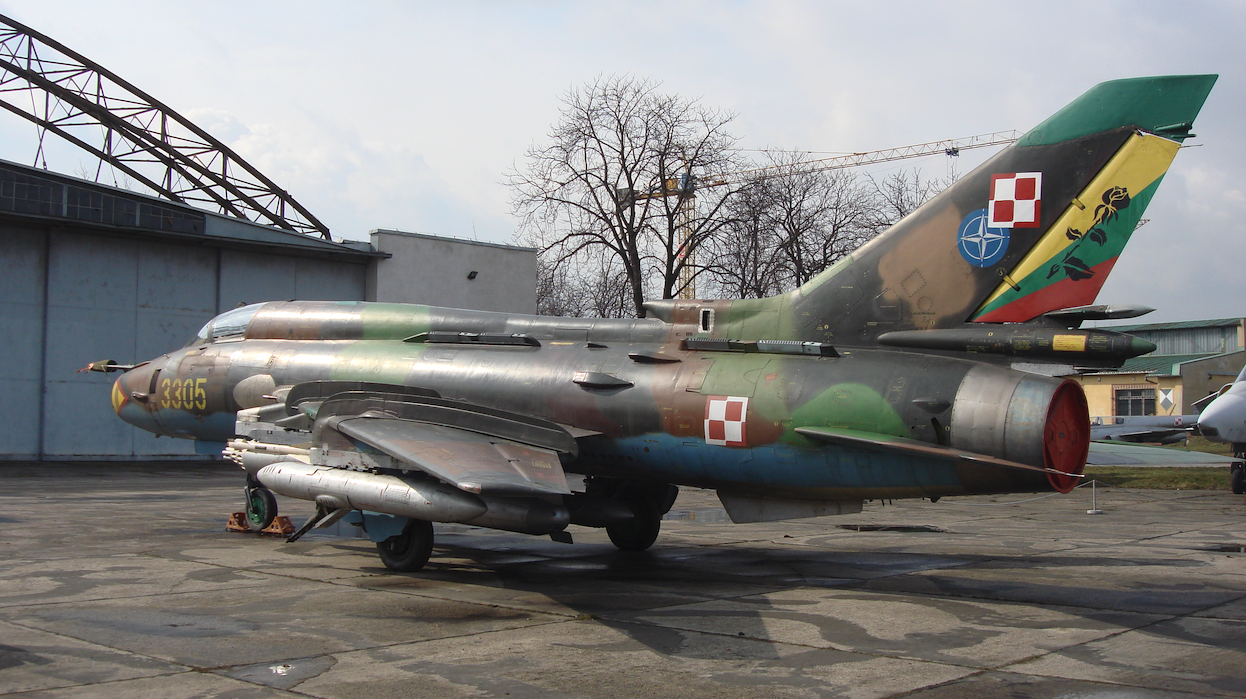
Written by Karol Placha Hetman
Kraków 2007-09-01
269 Section 1984-05-05
OKB Suchoj Su-22 M 4 K, Su-22 UM 3 K
Poland
Construction
Supersonic fighter-bomber plane with variable wing geometry.
Construction Su-22 M 4
One-seater, single-engine fighter-bomber plane. Built in a classic layout with a variable geometry wing. The fuselage is made of aluminum and titanium alloys.
The wings consist of a fixed part and external moving parts, 4 m long, taking two positions. The minimum skew angle is 30 degrees. The maximum 63 degrees. It is also the angle of skew of the fixed part of the wings. One and the other part are hinged together. At the front with a large bearing pin, which is the axis of rotation. On the back of the support is a four-wheeled trolley moving on guides mounted inside the stationary part. The movement is carried out by a hydraulic system. Fixed parts were equipped with two sections of slotted flaps on the canoe. The outer parts received ailerons and slit flaps on the path. On the leading edge there are three-sectional gills (slots). The wing received two pairs of high aerodynamic blades and three pairs of smaller aerodynamic blades that strengthen the construction of fixed wing parts. Covering of the wings was made by chemical etching. Steering surfaces were made of 3-ply glued boards with a honeycomb filler.
A fuselage with a half-shell structure and a section similar to a circular one. The maximum diameter is 1.75 m and the length of the hull is 15.572 m. The frame fuselage to No. 13 is tilted down by 3 feet. It is technologically divided into two parts. The division takes place at the number 34 frame. The removable rear part of the fuselage allows access to the engine. Front air grip with central intake cone that can take two positions. The cabin is hermetic and air-conditioned. It provides excellent working conditions and good visibility. The cabin was placed between frame number 4 and 9. Throw-out seat K-36 class 0-0. It allows you to safely leave the aircraft in the speed range from 0 km / h to 1 300 km / h, at any altitude. The cover opens upwards to the rear. A periscope was placed on the windshield to observe the rear half-zone. Four aerodynamic brakes are located in the rear of the fuselage.
The tail. Horizontal plate with 55 degrees angle on 25% chord. Mounted with a negative 3-degree lift. At the ends, anti-flutter masses were mounted. The shift is from +25 degrees 30 minutes to -10 degrees. The vertical elevation is divided into a rudder and a ballast. The skew is 55 degrees.
The aircraft has a three-points chassis with oil-pneumatic shock absorbers and hydraulic brakes. The front wheel, 660 x 200 mm, is pulled forward into the chamber under the cab floor. Main chassis with single wheels, size 880 x 230 mm. The base of the chassis is 5.24 m, the main chassis spacing is 3.85 m.
Construction Su-22 UM 3 K
Differences between one-seater and two-seater aircraft.
The plane has a double cabin. Aviators' seats were placed in tandem. A centralized catapulting system with K-36 DS 2 armchairs was introduced. The instructor's cabin was equipped with a periscope system similar to that used in Su-7 U aircraft. The place for the second seat was obtained at the expense of reducing the fuel tank No. 1. In general, the fuel supply decreased to 3 050 kg, and thus range.
Aircraft equipment modified by introducing the SAU-22 MU control system. An SPU-9 on-board telephone and MS-61 tape recorder have been added. The left cannon was dismantled, but the weight of the aircraft increased to 10,900 kg anyway. The lifting capacity of the weaponry decreased to 3,000 kg and therefore the second pair of sub-fuselage nodes have been abandoned.
Su-22 drive
Su-22 airplanes, depending on the customer, are equipped with an AL.-21 or R-29 engine. All Polish Su-22 planes were equipped with AL-21 engines, the same ones that were powered by Su-20 planes. These engines are being renovated in Poland in Warsaw.
AL.-21 is the engine of A. Lulka AL.-21 F-3 of 1 x 76.50 kN, and with the afterburning 1 x 110.00 kN. This engine is special adapted for flights at low altitudes. It is a single-flow turbine composed of; 14-stage axial compressor, annular combustion chamber, 2-stage turbine and afterburner. The engine is cooled by air drawn by 4 grips placed on the fuselage at the rear.
Kerosene fuel T-1, TS-1, RT. IPM-10 or synthetic WNII-50 oil. Unit fuel consumption 0.9 - 1.2 kg / daN / h, with afterburning 1.5 - 2.0 kg / daN / h. The engine's resure is 900 - 1500 hours depending on the production series. The period between repairs is 350 - 450 hours.
The fuel system consists of 4 tanks placed in the fuselage and two integral ones placed in the movable parts of the wings. In addition, the aircraft can carry 4 additional tanks (2 under the fuselage and 2 under the wings).
Equipment Su-17 M 3
- Automatic control system SAU-22 M 1. - KN-23 navigation complex comprising; IKW-8 inertial system, DISS-7 navigation radar, SWS-P-72 aerodynamic data center, data input panel and W-144 counters.
- Close navigation system RSBN-6 S.
- Fon-1400 laser rangefinder. - RW-15 radio altimeter - ASP-17 B dual-purpose sight.
- SPO-15 ŁS warning station.
- WRe. Active disruption station SPS-141 MWG Gwozdika in the tray.
- KDS-23 dipole ejector and thermal flares.
Equipment Su-17 M 4
- Navigation system coupled with a sighting device in one navigation and aiming system PRNK-54 (pricelno-navigation systemnyj complex) with on-board computer Orbita-20-22. Before the flight, the coordinates of the destination and turning points on the route are entered into the computer. The system allows attack in "all weather conditions".
- Automatic control system SAU-22 M 1.
- RSDN-10 long-distance navigation system (radiotiechniczeskaja sistiema NA navnio), which had no predecessor.
- VHF radiotelephone R-862.
- Radiometer RW-4 or newer RW-21.
- Klen-54.
- ARK-15 M or newer ARK-22.
- Fon-1400 laser rangefinder.
- The weapon system includes the ASP-17 B or newer optical sight.
- Automatic system to bypass obstacles on the fly at low altitudes.
- Automatic control system SAU-23 B. The machine can be guided automatically or manually by the remote control.
- Inertial course and IKW vertical division.
- Doppler speed and drift angle meter DISS-7.
- Active and passive noise systems.
- A warning system for radiating and firing an anti-aircraft missile, allowing automatic execution of an anti-missile maneuver. - Your own-foreign identification system.
- Transparent display on the windshield.
- Devices; SRO-2, SPO-10, MRP-66.
- Other.
Armament Su-22 M 4 K
The weight of the weapon is 4,000 kg. The aircraft has 10 points for weapons: 4 under the fuselage, 4 under the wings + 2 under the wings for the R-60, R-55 or R-13 class missiles. Permanent weaponry consists of two NR-30 machine guns, 30 mm caliber, construction by A. Nudelman and A. Richter, with a reserve of 160 missiles. Weight 66 kg, rate of fire 900 shots / min, projectile weight 410 g, and initial speed 780 m / s. The machine guns were placed in the wing caps.
Suspended armament
Shooting tank SPPU-22-01 controlled by a computer, with a total mass of 290 kg. The front features a GSz-23 double-barrel gun mounted on a mobile carriage, so it can be tilted downward by an angle of 23 degrees. At the back there is a control system and 260 rounds. The entire hopper can be suspended with both forward and backward barrels. Data to the computer must be entered before the flight - speed and flight altitude.
Another used shooting tank is UPK-23-250 also with a GSz-23 cannon but still. Own weight 78 kg, and after loading 250 pieces of bullets is 217 kg. Length 3,166 m, diameter 340 mm.
Guided missiles of the p-p class;
R-60 - has a mass of 45 kg, length 2.10 m, caliber 0.12 m. It targets targets from 200 to 7,200 m.
Guided p-z rocket missiles;
- K.p.r. H-25 with modular design. It is a widely used missile of MiG-27, Su-17, Su-24 and Su-25 aircraft. It has a replaceable head; radar guidance - H-25 MR (i711 dissection), laser - H-25 ML (ireland 713) or radiolocation - H-25 MP (ireland 711). Depending on the version, it has a mass of 300 - 320 kg. The weight of the warhead is 90 kg. The missiles fly at a speed of 850 - 900 m / s. The length is 4.353 m, caliber 0.275 m.
- K.p.r. - H-29 L (and laser beam 64) laser-guided. It is the heaviest projectile carried by an airplane. Weight 657 kg, including 317 kg warhead. Range 8 - 10 km. dimensions; length 3.875 m, span 0.78 m, caliber 0.38 m. Used to combat heavily armored purposes.
- H-58 - against radar.
- K.p.r. older generation - H-23 and H-28.
Unguided missiles with caliber from 57 to 370 mm;
- S-5 caliber 57 mm, fired from the UB-32 reservoir.
- S-24. - S-8 caliber 80 mm, fired from container B-8 M 1 with 20 pieces. Missile mass 11.65 kg, warhead 3.6 kg, length 1.445 mm. In the anti-tank version S-8 KO pierces armor with a thickness of 420 mm.
- S-13 caliber 122 mm, fired from container B-13 with 5 pieces. The missile comes in two versions; anti-tank S-13 T, mass 67 kg, pierce armor with a thickness of 1000 m and S-13 OF, mass 68 kg, at the moment of explosion produces 1,800 pieces.
- S-25 over-calibrated 370 mm. Has several versions. In Poland, the used S-25 OF churning and breaking, mass 480 kg, warhead 190 kg, length 3.31 m, caliber 340 mm. It covers an area of 1 820 square meters.
Bombs;
- FAB-500 L - 500 kg mass, laser guided.
- FAB-500 M-62 - developed in 1962. length 2.43 m, caliber 400 mm, bends the area with an area of 1 500 square meters.
- ODAB-500 P fuel and air bomb.
- OFAB-250-270. - OFAB-100-120 - cluster bombs weighing 1-2.5 kg; AO-1 SCz, AO-2,5 RT (fragment), ZAB-2,5 (incendiary), PTAB-2,5 (armor-piercing). Placed in cassettes; RBK-250, RBK-500, KMGU (length 3.70 m, diameter 460 mm, weight 525 kg).
Polish bomb cassettes produced in "Dezamecie" in Nowa Dęba;
- ZK-300 Kisajno (cassette container), length 3.40 m, diameter 450 mm, weight 465 kg, including 252 kg 315 LBOk-1 ball bombs. The cassette consists of three sections. After the discharge flies freely up to a distance of 3 km. After the set time, he starts; the front section at a 30-degree angle to the left, the middle section to the left and right, the rear section at a 30-degree angle to the right. Bombs fly by packages of 3-4 pieces. After free flight, they fire from each other. LBOk-1 bomb with a diameter of 67 mm, weight 0.8 kg, including 0.16 load, and inside one-gram balls with a diameter of 6.35 mm. radius of destruction 40 m .
- ZR-8 (tubular container). It has 8 packages with ball bombs fired back. There are also ZR-2 and ZR-4.
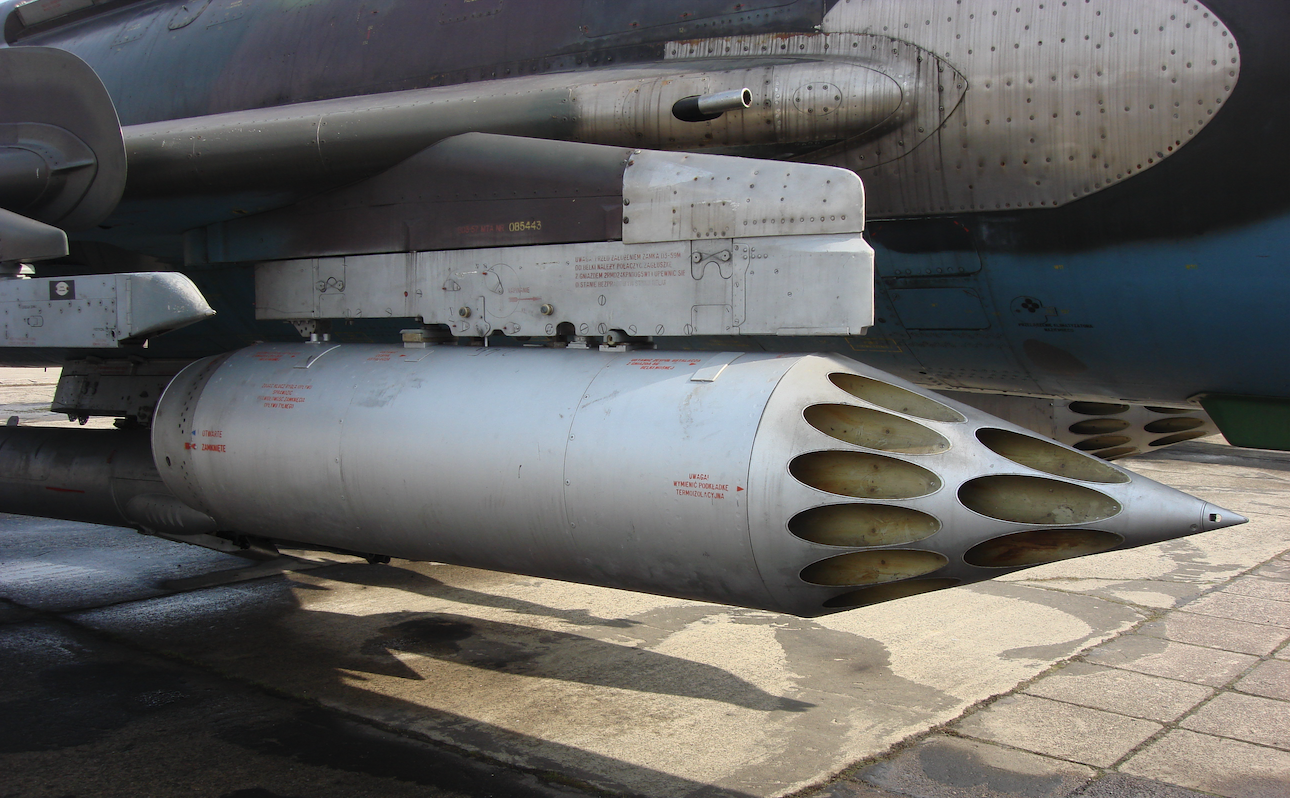
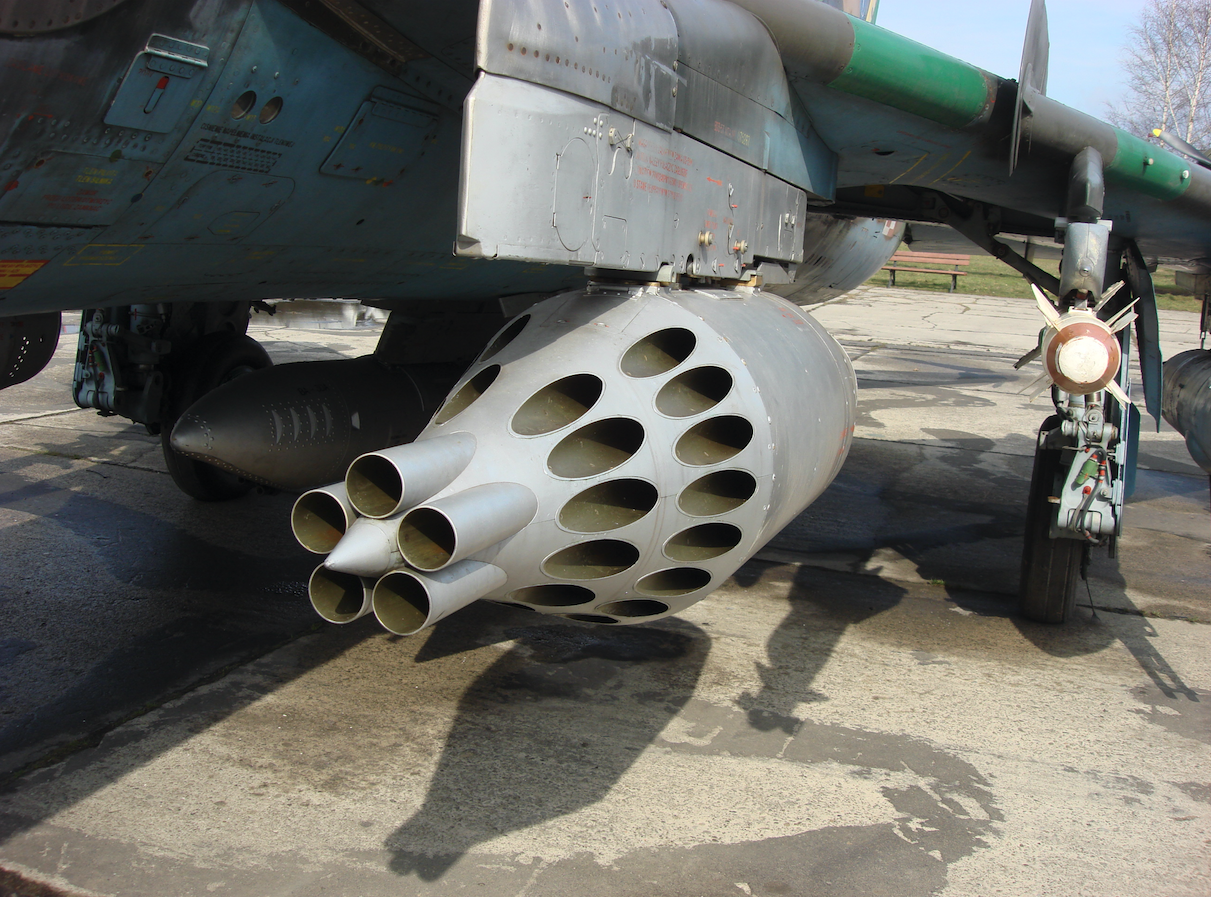
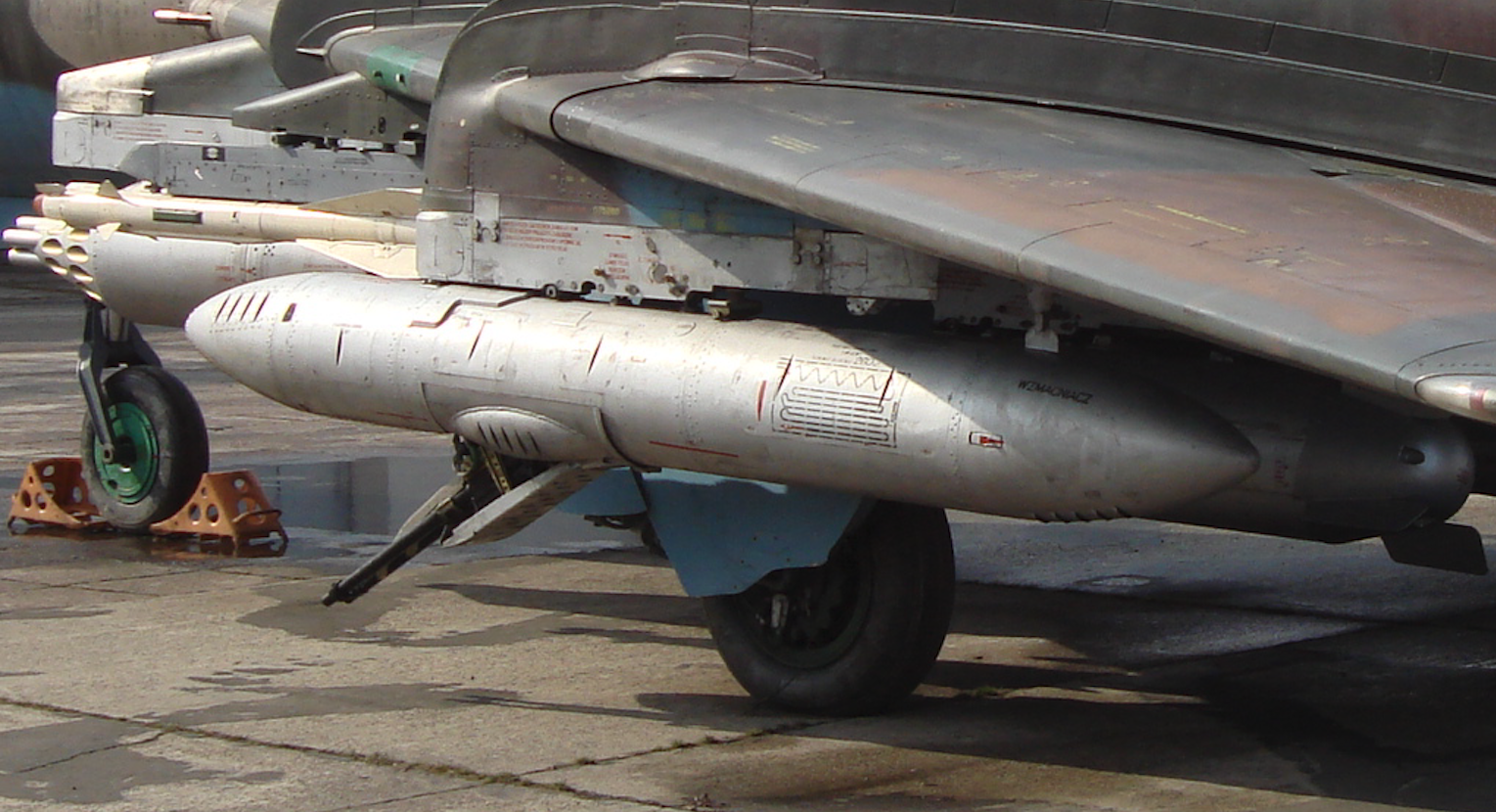
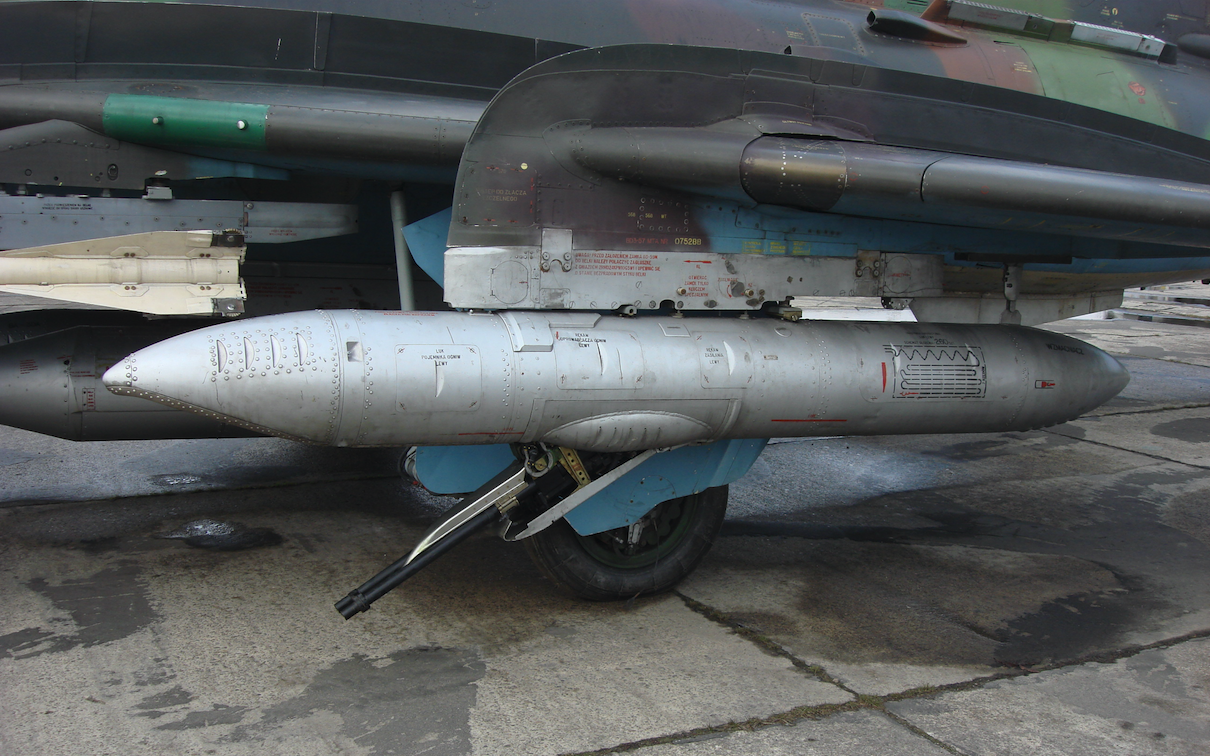
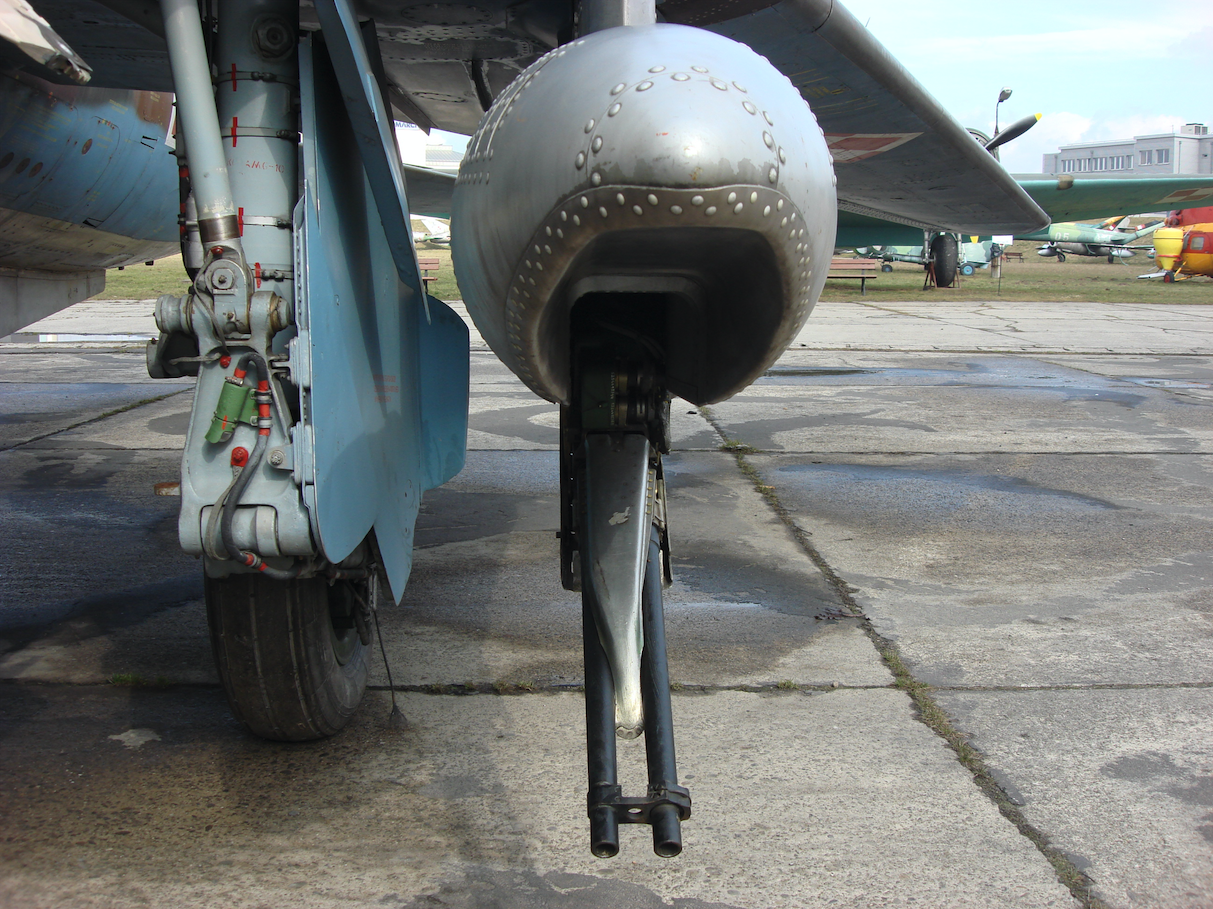
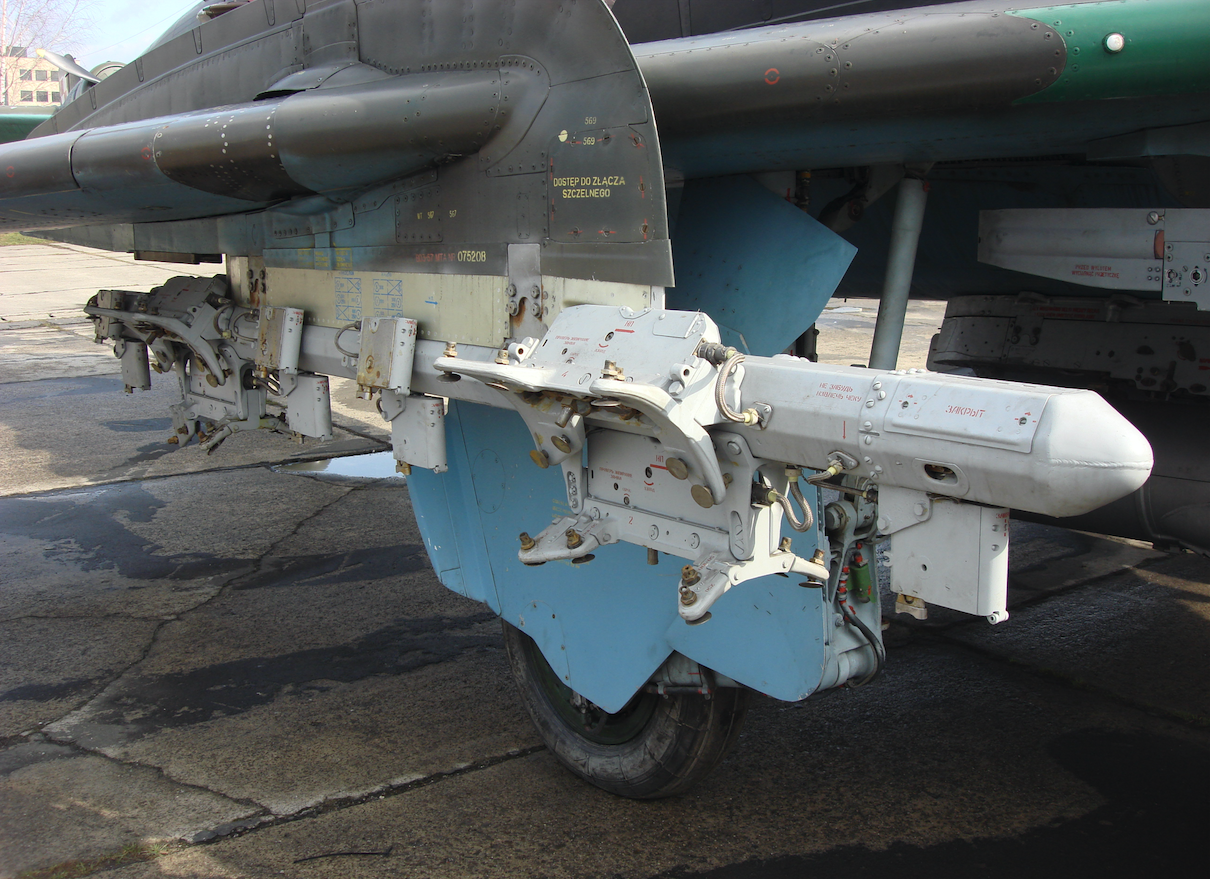
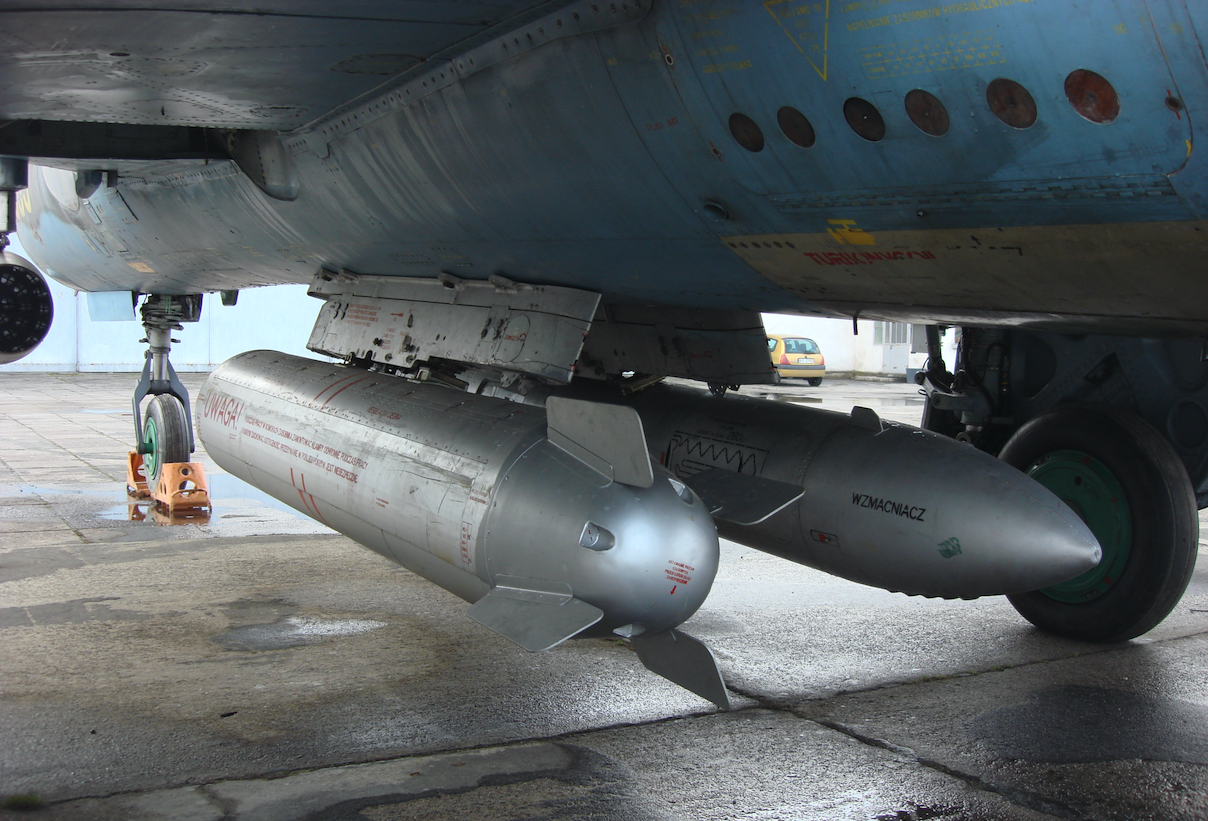
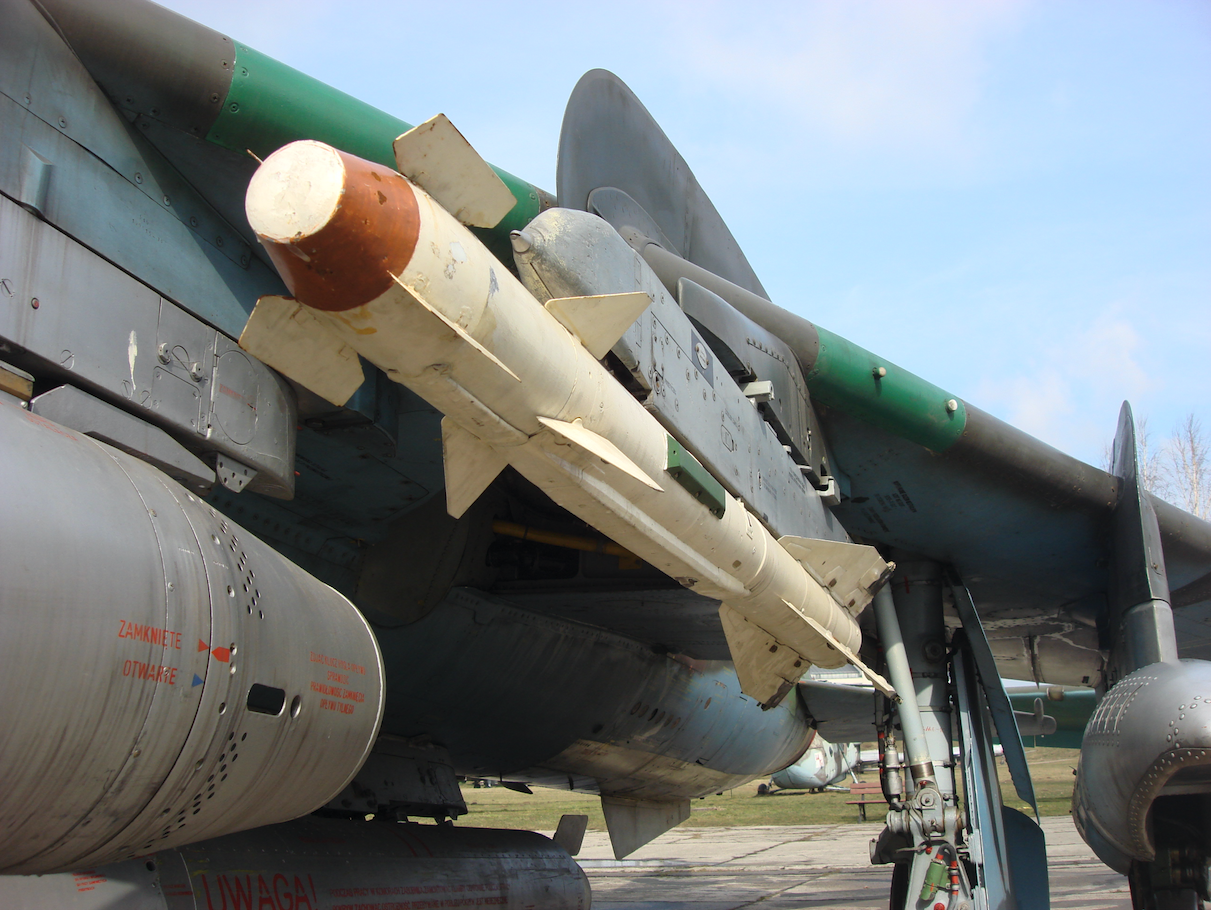
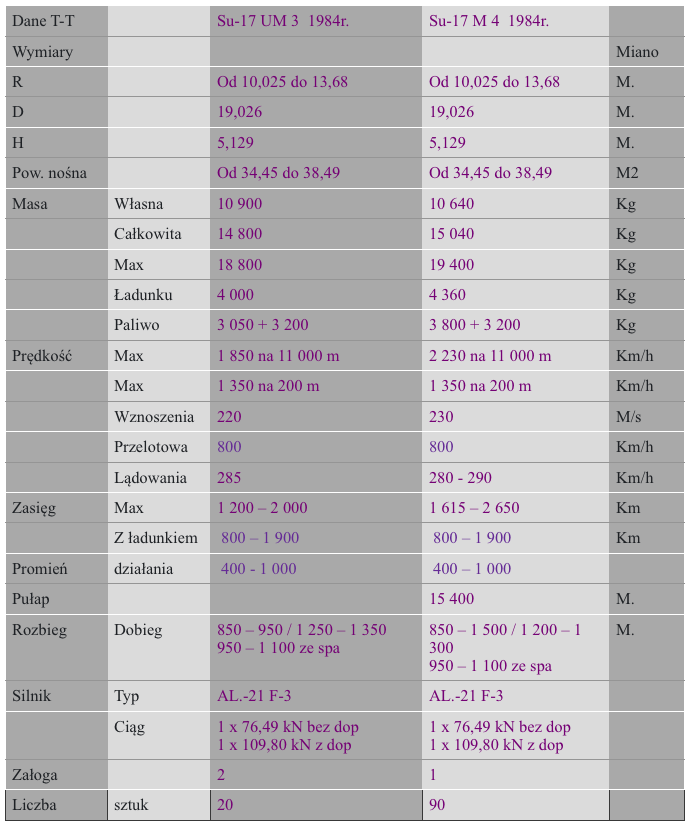
Written by Karol Placha Hetman
